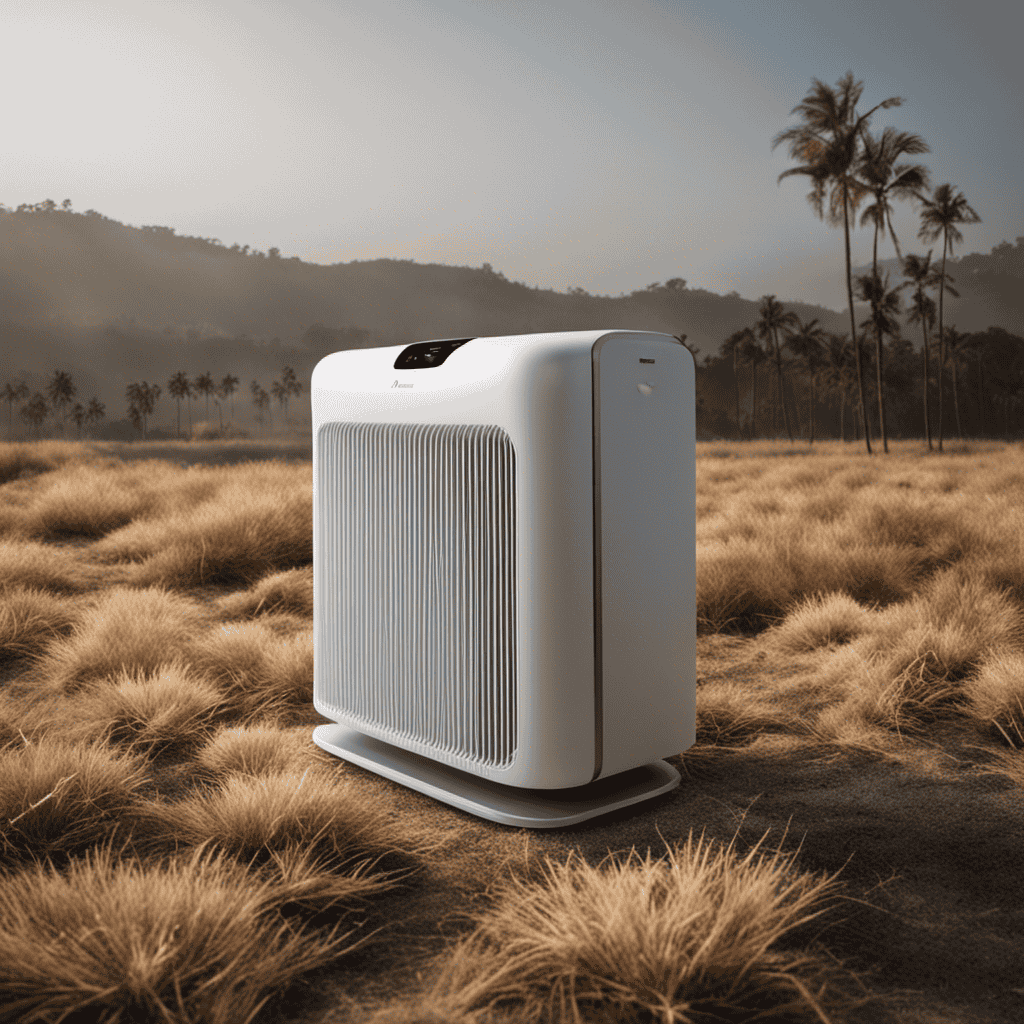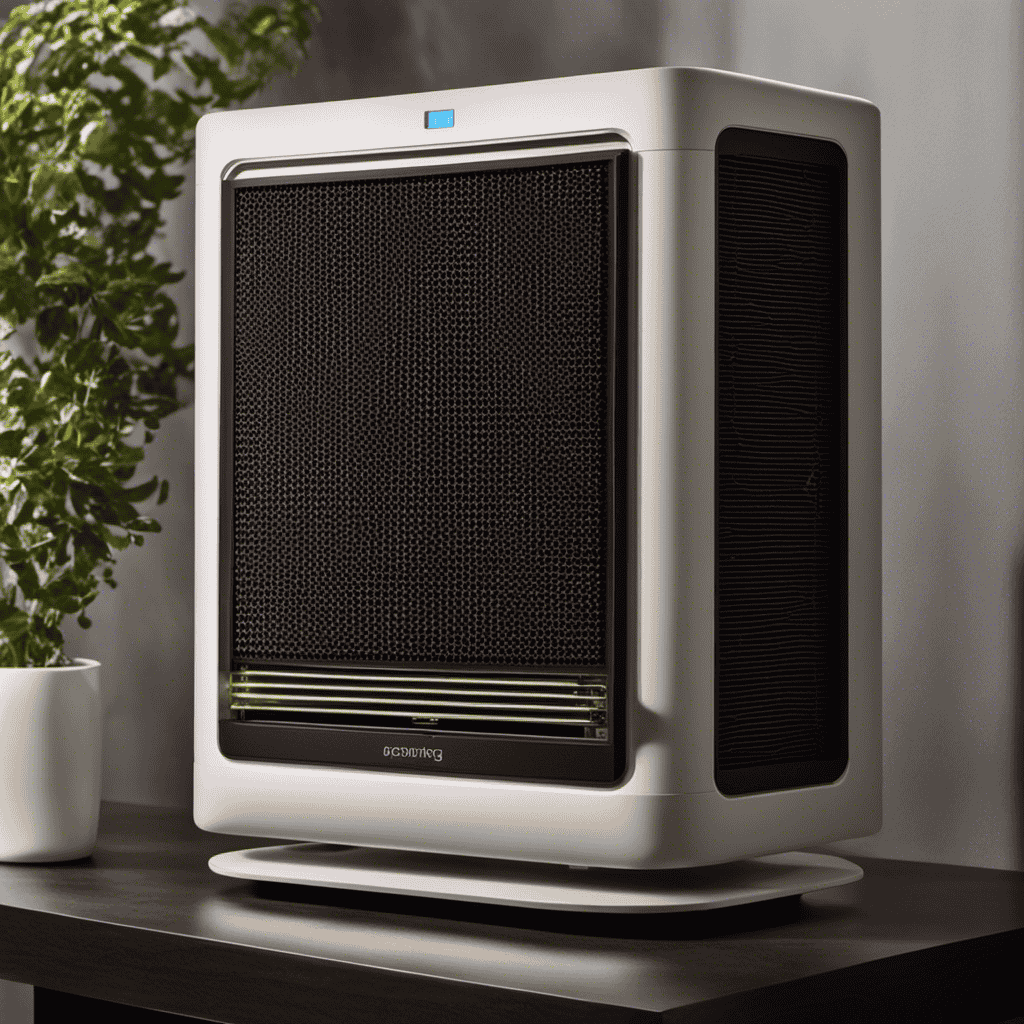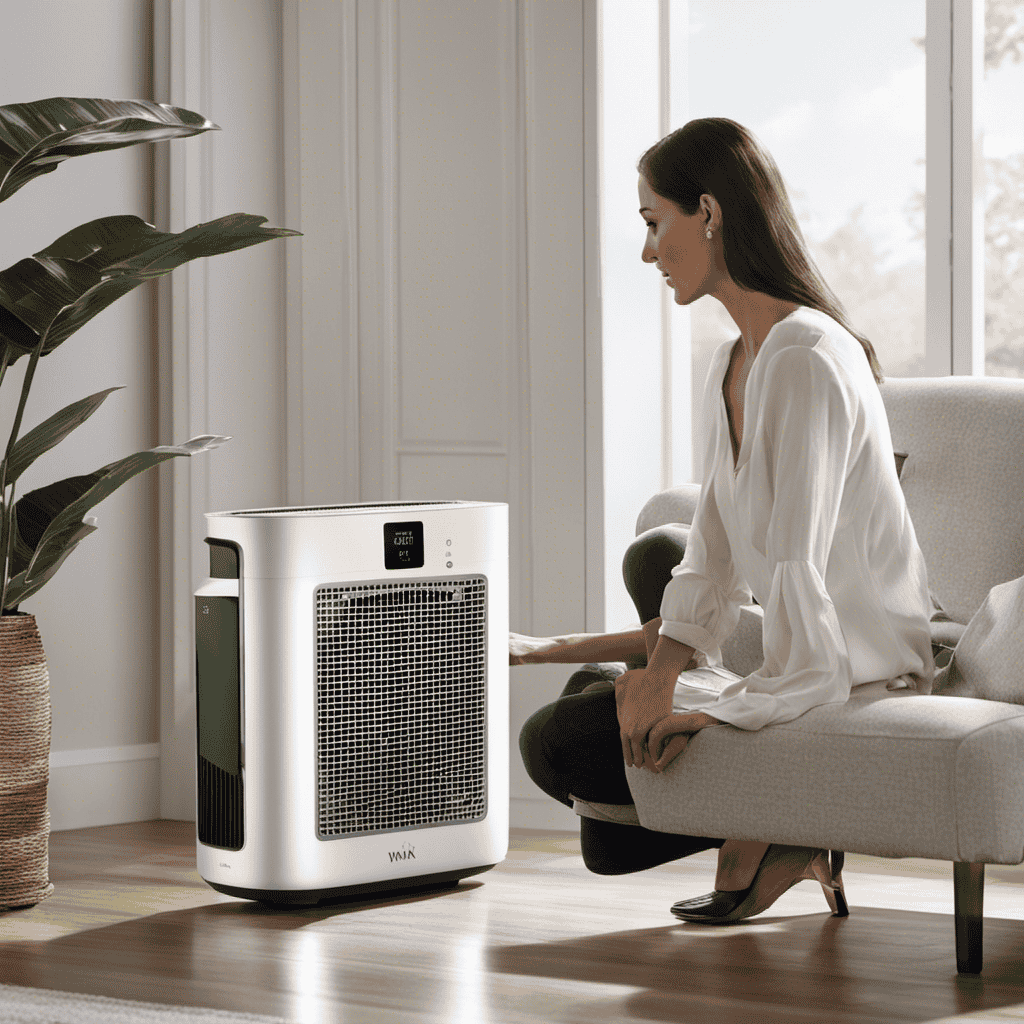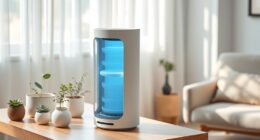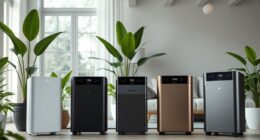Seated comfortably in my living area, I enthusiastically extend my hand towards the power switch of my Honeywell air purifier, only to be greeted by quiet. My frustration grows while I ponder over the reason my reliable appliance won’t power up.
In this article, we will delve into the possible reasons behind this perplexing issue. From power supply problems to clogged filters, we will explore the technical troubleshooting steps to bring life back to your air purifier.
Key Takeaways
- Power surges can overload the circuitry and prevent the air purifier from starting, so using a surge protector or unplugging the purifier during thunderstorms is recommended.
- Insufficient power may be caused by an electrical outlet problem or loose connection, so trying a different outlet or contacting an electrician to fix wiring problems can resolve this issue.
- The power button should be checked for physical damage and cleaned to remove dirt or debris that may affect its functionality. Resetting the power button by unplugging the purifier and waiting before plugging it back in can also help.
- Clogged filters can hinder the air purifier’s performance, so regularly cleaning or replacing them is necessary. Proper installation of cleaned or new filters is also important for optimal functionality.
Power Supply Issues
The most common reason why your Honeywell air purifier isn’t turning on is because of power supply issues. One possible cause is a power surge, which can overload the circuitry and prevent the purifier from starting. This often happens when there is a sudden increase in the electrical current flowing into the device.
To prevent power surges, it is recommended to use a surge protector or unplug the purifier during thunderstorms.
Another potential issue could be an electrical outlet problem. If the outlet is not providing a steady flow of electricity or if there is a loose connection, the purifier may not receive enough power to turn on. In such cases, it is advisable to try plugging the purifier into a different outlet or contacting an electrician to fix any wiring problems.
Faulty Power Button
One possible reason could be a faulty power button. If your Honeywell air purifier is not turning on, it is important to check the power button for any issues. Here are some troubleshooting techniques to help you repair a faulty power button:
- Inspect the power button for physical damage, such as cracks or loose connections.
- Clean the power button using a soft cloth and mild cleaning solution to remove any dirt or debris that may be affecting its functionality.
- Reset the power button by unplugging the air purifier from the power source and waiting for a few minutes before plugging it back in.
- If the power button still doesn’t work, consider replacing it with a new one to ensure proper functionality.
Clogged Filters
To address clogged filters, you should regularly clean or replace them to maintain optimal performance in your Honeywell air purifier. The cleaning process is relatively simple. First, make sure the unit is turned off and unplugged. Remove the front grille and carefully take out the filters. If they are washable, rinse them gently with lukewarm water and mild soap. Allow them to dry completely before placing them back into the purifier. If the filters are not washable, you will need to purchase replacement filters. Honeywell offers a variety of replacement filters specific to each model. Simply remove the old filters and insert the new ones according to the manufacturer’s instructions. Regularly cleaning or replacing clogged filters will ensure that your air purifier continues to function effectively.
Now, let’s move on to the next possible issue: a malfunctioning fan.
Malfunctioning Fan
I believe the malfunctioning fan in your air purifier could be caused by a power supply issue, a faulty electrical connection, or a defective fan motor.
First, check if the power supply is functioning properly by ensuring that the unit is plugged into a working outlet and the power switch is turned on.
If the power supply is not the problem, inspect the electrical connections for any loose or damaged wires that may be interrupting the fan’s operation.
Lastly, the fan motor itself may be defective, in which case it would need to be replaced to restore proper functionality to your air purifier.
Power Supply Issue
The issue might be that the power cord isn’t properly plugged in. To troubleshoot the power cord and electrical outlet problems, follow these steps:
-
Check the power cord connection: Ensure that the power cord is securely plugged into both the air purifier and the electrical outlet. Sometimes the cord can become loose due to movement or accidental disconnection.
-
Inspect the power cord for damage: Look for any visible signs of damage such as frayed wires or cuts. If you notice any, it’s crucial to replace the power cord to avoid electrical hazards.
-
Test the electrical outlet: Try plugging another device into the same electrical outlet to see if it works. If the outlet is not providing power, you may need to reset the circuit breaker or contact an electrician to address the issue.
-
Consider using a different outlet: If the outlet is functioning correctly, try plugging the air purifier into a different outlet to see if it powers on. This will help determine if the issue lies with the outlet or the air purifier itself.
Faulty Electrical Connection
If the power cord and electrical outlet are not the issue, you may have a faulty electrical connection. A faulty outlet or loose wiring can prevent your Honeywell air purifier from turning on.
To determine if your outlet is faulty, you can try plugging another device into the same outlet. If the device doesn’t work, then the outlet is likely the problem. In this case, you should contact a qualified electrician to inspect and repair the outlet.
Loose wiring can also cause a faulty electrical connection. Check the power cord of your air purifier for any loose or frayed wires. If you find any, it is important to stop using the device immediately and have it repaired by a professional.
Defective Fan Motor
To determine the cause of the issue, check the fan motor for any signs of defects or damage. Here are some troubleshooting tips to help you identify if your fan motor is defective:
-
Strange noises: If you hear unusual sounds coming from the fan motor, such as grinding or squeaking, it could indicate a mechanical issue that requires fan motor replacement.
-
Lack of airflow: If your air purifier is not producing enough air circulation, it could be due to a faulty fan motor. Inspect the motor for any obstructions or blockages that may be hindering its operation.
-
Overheating: If the fan motor feels excessively hot to the touch or if the air purifier shuts off unexpectedly, it could be a sign of a defective motor. Overheating can cause the motor to malfunction and require replacement.
-
Motor not running: If the fan motor is not running at all, it could be a result of a faulty connection or a burnt-out motor. In such cases, replacing the fan motor may be necessary to restore functionality to your air purifier.
Sensor Malfunction
I’m going to discuss the topic of sensor malfunction, which can be caused by a few key issues.
Firstly, faulty sensor wiring can lead to inaccurate readings or a complete failure of the sensor.
Secondly, sensor calibration issues can result in incorrect data being collected and processed.
Faulty Sensor Wiring
The most common reason for a Honeywell air purifier not turning on is faulty sensor wiring. When the sensor wiring becomes damaged or loose, it can disrupt the communication between the sensor and the control panel, preventing the air purifier from powering on.
To address this issue, follow these steps:
- Inspect the sensor wiring for any visible signs of damage, such as frayed or disconnected wires.
- If any damage is found, replacement of the sensor wiring may be necessary.
- Ensure that all connections are securely fastened and properly seated to the control panel and sensor.
- Regular sensor maintenance, such as cleaning and checking for debris, can help prevent issues with the wiring.
By addressing faulty sensor wiring, you can resolve the issue of your Honeywell air purifier not turning on.
However, if the problem persists, it may indicate sensor calibration issues, which will be discussed in the next section.
Sensor Calibration Issues
Sensor calibration issues can cause the Honeywell air purifier to malfunction and not turn on properly. Calibration troubleshooting is essential to ensure accurate sensor readings and proper functioning of the air purifier. If the sensors are not calibrated correctly, they may provide inaccurate information, leading to errors in the purifier’s operation.
To troubleshoot calibration issues, follow these steps:
-
Check the sensor connections: Ensure that all sensor cables are securely connected to the control unit.
-
Reset the calibration settings: Some models have a reset button or an option in the menu to reset the sensor calibration settings.
-
Contact customer support: If the issue persists, it is recommended to contact Honeywell customer support for further assistance and possible sensor error solutions.
Power Supply Problems
Power supply problems can prevent the Honeywell air purifier from functioning properly. Here are four common issues related to power supply that may be causing your air purifier to not turn on:
-
Power cord issues: Check if the power cord is securely plugged into the air purifier and the power outlet. A loose connection can prevent the device from receiving power.
-
Power outlet problems: Ensure that the power outlet is working properly by testing it with another device. Faulty outlets or blown fuses can disrupt the power supply to your air purifier.
-
Power surge: If there was a recent power surge or outage, it could have affected the air purifier’s internal components. Unplug the device for a few minutes, then plug it back in to see if it resets.
-
Faulty power switch: The power switch on the air purifier may be malfunctioning. Try toggling the switch on and off several times to see if it makes a difference.
Technical Troubleshooting
Did you check if the air purifier is properly plugged in? Sometimes, the simplest solution is the most overlooked one. Before diving into technical troubleshooting, ensure that the power cord is securely connected to both the air purifier and the electrical outlet. If the issue persists, there are a few steps you can take to troubleshoot your Honeywell air purifier.
First, try resetting the air purifier settings. This can often resolve minor software glitches that may be causing the device to malfunction. To do this, locate the reset button on the purifier and press and hold it for 10 seconds. If the purifier has a digital display, it should reset to its default settings.
Additionally, it’s worth checking for firmware updates. Manufacturers occasionally release updates that can improve the performance and stability of their devices. Consult the user manual or visit Honeywell’s website to see if any updates are available for your specific model.
Here is a table summarizing the steps for technical troubleshooting:
| Steps | Action | Result |
|---|---|---|
| Check the power connection | Ensure the power cord is securely plugged in | Resolves power supply issues |
| Reset air purifier settings | Locate the reset button and press and hold it for 10 seconds | Resolves software glitches |
| Check for firmware updates | Consult the user manual or manufacturer’s website for update options | Improves performance and stability |
Frequently Asked Questions
Can I Use a Different Power Adapter for My Honeywell Air Purifier if the Original One Is Not Working?
Yes, you can try using a different power adapter for your Honeywell air purifier if the original one is not working. Troubleshooting power issues can involve testing different adapters to see if they provide the necessary power.
Is It Possible to Repair a Faulty Power Button on My Honeywell Air Purifier?
It is possible to repair a faulty power button on a Honeywell air purifier. Troubleshooting power issues and repairing the power button may require disassembling the unit and replacing the faulty component.
How Often Should I Clean or Replace the Filters in My Honeywell Air Purifier?
I clean the pre filter in my Honeywell air purifier every 3 months. Regular cleaning ensures optimal performance and extends the lifespan of the purifier. Using a Honeywell air purifier reduces allergens, odors, and airborne pollutants.
What Should I Do if the Fan on My Honeywell Air Purifier Is Not Working Properly?
If my Honeywell air purifier fan isn’t working properly, I would start by troubleshooting common fan issues. I would check for obstructions, clean the fan blades, and make sure the power is properly connected.
How Can I Troubleshoot a Sensor Malfunction in My Honeywell Air Purifier?
To troubleshoot a sensor malfunction in my Honeywell air purifier, I would start by checking for common issues like dirty sensors or loose connections. Cleaning the sensors and ensuring proper connections can often resolve the problem.
Conclusion
In conclusion, after thorough technical troubleshooting, I’ve identified several potential reasons why your Honeywell air purifier may not be turning on.
From power supply issues to faulty power buttons, clogged filters, malfunctioning fans, and sensor malfunctions, there are various factors that could be hindering its operation.
However, the suspense remains as we delve deeper into these possibilities to uncover the precise cause of the problem.
Stay tuned for further investigation and guidance on resolving this issue promptly and efficiently.



